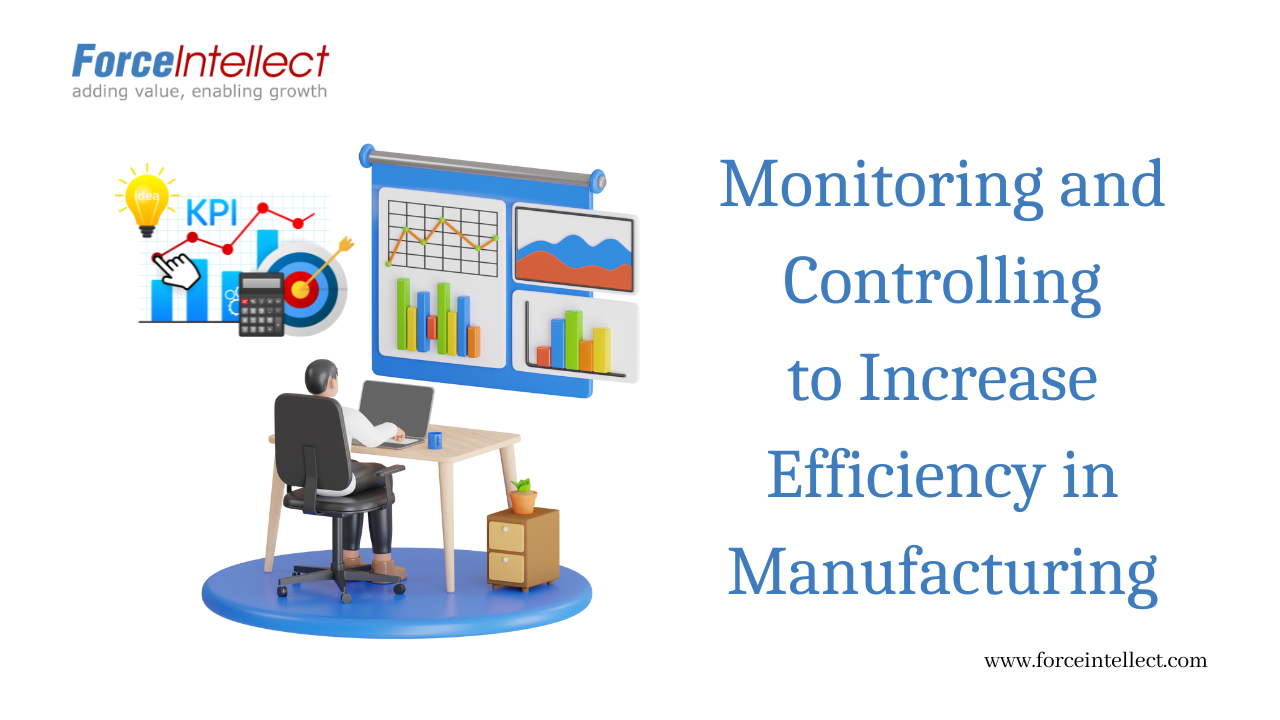
Implement Monitoring and Controlling to Increase Efficiency in Manufacturing
Manufacturing companies must focus on operational efficiency to ensure optimum utilization of resources, improve productivity & maximize profitability. Closely monitoring and controlling performance, plays a very important role, as it helps ensure continuous improvement to achieve the above-mentioned objectives.
Monitoring helps you to know where the present state of a business function is as compared to a standard or planned one. Controlling involves corrective measures taken to bring that business function to the desired stage. E.g. organizations monitor production cost, product quality, timely delivery, and customer satisfaction.
Let us now discuss monitoring and controlling in more detail, why it is beneficial for manufacturing industries, and how to implement it effectively.
What is monitoring and controlling in manufacturing?
Monitoring: Monitoring involves constant observation of the manufacturing process. Companies must monitor everything from raw material procured, inventory level, production rate, quality, equipment performance, etc. This allows to identify bottlenecks, and anticipate likely issues, for taking actions accordingly.
Controlling: Controlling involves actions taken based on data gathered from monitoring. It includes activities such as streamlining processes, resource re-allocation, and taking corrective measures to ensure the predefined targets are achieved.
Thus, monitoring and controlling involves defining performance standards and processes to monitor the performance closely. Manufacturing companies must define Key Performance Indicators (KPIs) and track the performance of processes across various departments such as Finance, Production, Quality, Dispatch, Inventory, etc.
Effective monitoring control mechanisms ensure that operations run smoothly & efficiently. Let us now read about the benefits in more detail.
Why should manufacturing companies implement it? What are the benefits?
Implementing monitoring and controlling provides multiple benefits such as:
- Enhanced Efficiency: By monitoring operations closely manufacturing companies can streamline workflows, minimize downtime, and optimize resource utilization
- Improve Quality: Monitoring enables early detection of quality issues. Companies can quickly take corrective actions, and prevent defective products from reaching customers.
- Cost Reduction: Continuous monitoring helps identify leakages and waste in different processes. Thus, companies can cut unnecessary expenses and work towards achieving cost reduction.
- Compliance and Risk Mitigation: Preparing a checklist, setting up reminders, and closely monitoring help ensure regulatory compliance. This prevents chances of fines and penalties. Thus, saving costs and stress.
- Data-Driven Decision Making: Defining and monitoring KPIs enables management to make informed decisions for continuous improvement.
What are the steps to implement monitoring & controlling?
- Define Key Performance Indicators (KPIs): Firstly, define your manufacturing business’ goals and objectives. Accordingly, identify the critical metrics that will help you achieve the goals. Some examples of KPIs are production output, cycle time, scrap rate, equipment uptime, etc.
- Define performance standards: These standards are goals set for your team. The objective is to work together, collaborate & perform to meet the desired standard. E.g. Unit production cost, Monthly Production, Timely Delivery Percentage, Plant Maintenance Effectiveness.
- Measure Performance: Set the processes and standards to collect the data and measure performance. The measurement process should be able to capture all relevant data. Your company should define who will provide data, at what frequency it will be calculated etc.
- Compare Actual Vs Standard Performance: Find out the variance between standard vs actual performance. Analysis for the cause of variance is also done at this stage. Finding out the cause of variance is important so that corrective action can be taken to achieve standard performance consistently.
- Take Corrective Action: In this step, manufacturing companies must study the performance data, identify trends, and take action to eliminate or reduce the gap between the standard and actual performance.
How does ERP help implement monitoring & controlling in manufacturing?
Enterprise Resource Planning (ERP) solutions facilitate implementing monitoring and controlling measures in manufacturing by enabling:
- Centralized Data: ERP solutions integrate data from various departments and functions into a centralized location and offer real-time visibility.
- Process Standardization: ERP helps set up standard workflows and procedures across the company. This ensures best practices are adhered to and consistency is achieved.
- Reports & Analysis: ERP offers dashboards & detailed reports to monitor KPIs and performance metrics easily. Companies can define automatic alerts for deviations. This helps take prompt corrective action. E.g. RAG Reporting
Summary
In manufacturing companies, monitoring and controlling business processes is essential to ensure that the company performs at its full potential. Leverage ERP to implement monitoring and controlling measures in your manufacturing company to maximize resource utilization, and achieve greater efficiency, productivity, and profitability to gain a competitive edge.
Request a Demo of Spectrum ERP Solution Now!
Contact Us for more information

